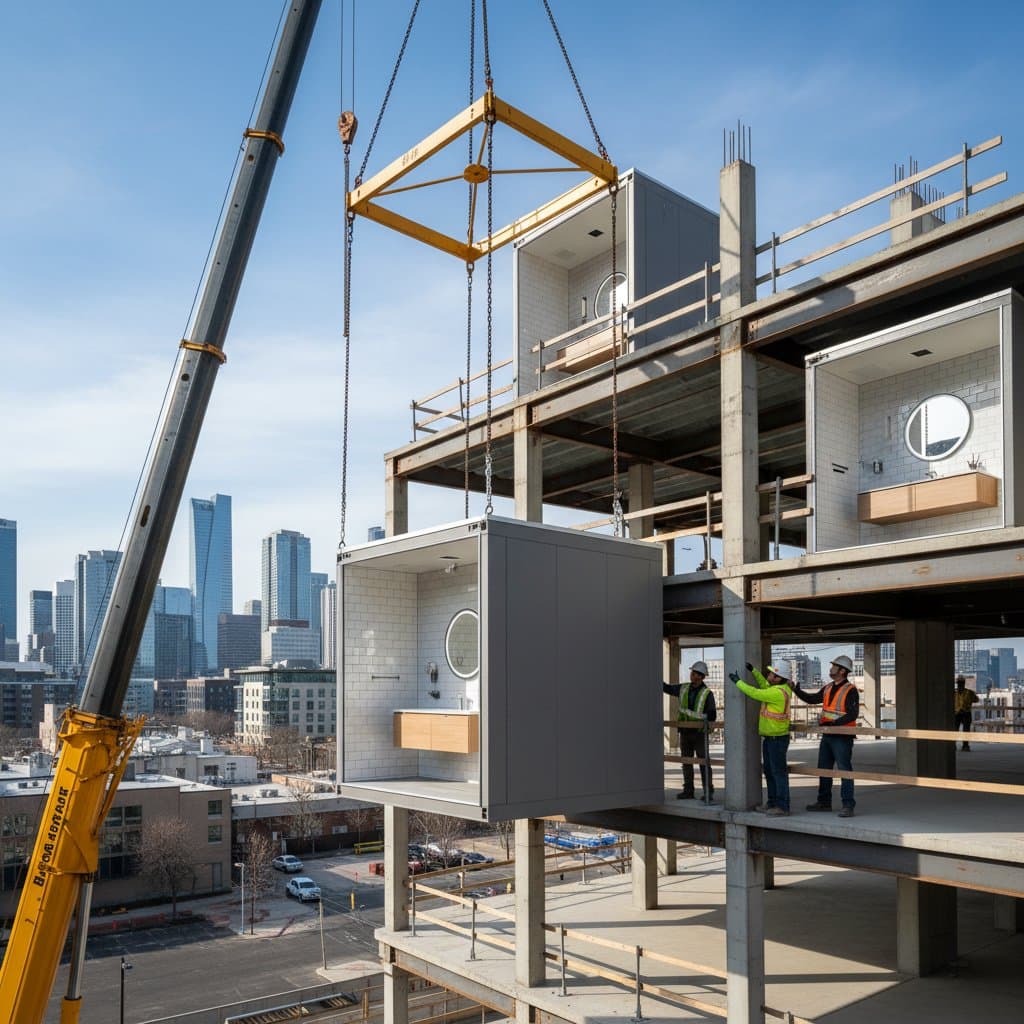Prefab Bathroom Pods: Uncovering Time and Cost Savings
Construction sites often face delays in bathroom builds due to sequential trades and material issues. Prefabricated bathroom pods offer a solution by arriving as fully assembled units. This approach accelerates timelines and enhances efficiency without sacrificing aesthetics or functionality.
Understanding Prefab Bathroom Pods
Prefabricated bathroom pods consist of fully assembled, self-contained units produced in a factory setting. These pods include walls, floors, fixtures, tiles, and lighting upon delivery. Installation involves positioning the pod within the structure, linking it to plumbing and electrical systems, and securing it in place.
Such pods prove advantageous for hotels, apartment complexes, student residences, and expansive homes. Their primary benefits include rapid deployment and reliable quality control.
Achieving a Three-Week Timeline Reduction
Traditional bathroom construction demands sequential steps: framing, plumbing, waterproofing, tiling, and fixture installation. Each phase relies on the prior one's completion, which prolongs the overall process.
Prefabricated pods disrupt this sequence. Factory production occurs parallel to on-site structural preparation. Upon building readiness, pods integrate swiftly, yielding a three-week savings in many projects. Larger-scale initiatives with multiple pods may realize even greater efficiencies.
Beyond speed, accelerated projects lower labor expenses and mitigate disruptions from weather or trade availability. These reductions convert time gains into tangible financial benefits and streamlined operations.
Breaking Down the Actual Costs
Prefabricated bathroom pods may carry a higher per-unit price than on-site builds due to manufacturing precision, transport, and setup. However, factoring in diminished on-site labor, reduced waste, and abbreviated timelines reveals balanced or lower total expenditures.
Consider this structured overview:
-
Manufacturing and Materials
Factory conditions ensure precise assembly, minimizing material overuse. Tiles align flawlessly, seals form uniformly, and finishes apply in dust-free environments. -
Transportation and Installation
Shipping and crane requirements introduce expenses, yet pod placement completes in hours rather than days. This brevity offsets logistical costs. -
Labor and Coordination
On-site work eliminates sequential trade involvement. Connection teams handle final links, while factory expertise streamlines the bulk of the process. -
Maintenance and Durability
Controlled production yields fewer initial defects. Enhanced waterproofing, a frequent on-site challenge, performs more dependably over time.
Customization Options in Prefab Design
Early prefabricated models offered limited variety, but current offerings provide substantial personalization. Select from diverse tile palettes, fixture types, mirror designs, and illumination configurations. Advanced providers accommodate custom wall treatments, integrated shelving, or optimized storage solutions.
Limitations exist for intricate geometries, non-standard configurations, or luxury custom elements, which escalate pricing. Optimal outcomes arise from incorporating pod specifications into initial planning. Align floor plans, utility routes, and visual preferences accordingly.
Ideal Applications for Prefab Pods
Prefabricated pods excel in repetitive designs across multi-unit structures such as residential towers, hospitality venues, or educational housing. They also support residential additions like guest areas or garage conversions.
Scale amplifies their value when replicating bathroom layouts. For singular bespoke residences, evaluate based on priorities: prioritize expedition, minimal disruption, and assured standards with pods. Opt for conventional methods if elaborate artisanal details or unique mosaics take precedence.
Overlooked Benefits of Prefab Implementation
Measurable time reductions represent one advantage, yet prefabricated pods address concealed expenses as well. Decreased on-site debris lowers disposal charges. Reduced personnel presence curtails safety hazards and insurance premiums. Reliable schedules avert minor setbacks from extending into major postponements.
Environmental gains emerge from efficient factory material use. Excess components recycle on-site, diminishing waste compared to field construction and lessening ecological impact.
Key Factors to Evaluate Before Adoption
Prior to selecting prefabricated pods, address these essentials:
- Site Accessibility: Confirm capacity for oversized deliveries and lifting equipment.
- Utility Integration: Ensure building systems align exactly with pod requirements. Engage builders or engineers for verification.
- Compliance Standards: Verify adherence to regional codes. Established producers supply comprehensive documentation; review it promptly.
- Long-Term Adaptability: Future modifications demand more effort than in conventional setups. Favor enduring, versatile selections.
Experiencing the Final Installation
Installed prefabricated bathrooms deliver the comfort of premium traditional spaces. Precision ensures aligned tiles, consistent grout, and effective moisture barriers. Daily use reveals seamless functionality akin to meticulously crafted designs.
The value extends to assurance: off-site complexities yield a serene on-site finish. This reliability elevates the overall satisfaction of the completed area.
Steps to Integrate Prefab Pods into Your Project
For upcoming renovations or constructions, investigate prefabricated options early. Consult vendors on production durations, tailoring possibilities, and installation assistance.
Prefabricated bathroom pods redefine building practices by infusing industrial accuracy into architectural spaces. They simplify intricate areas, fostering predictability and productivity.
Witnessing a pod's precise placement, fully realized to the finest detail, highlights its elegance. Expect shorter waits, eliminated uncertainties, and spaces primed for immediate occupancy.
